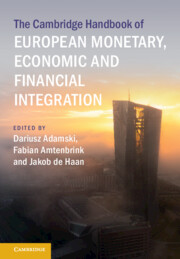Book contents
- The Cambridge Handbook of European Monetary, Economic and Financial Integration
- The Cambridge Handbook of European Monetary, Economic and Financial Integration
- Copyright page
- Contents
- Contributors
- Introduction
- Part I The Economic and Monetary Union
- 1 Conceptual Foundations of Economic and Monetary Union
- 2 Theorizing Economic and Monetary Union
- 3 Monetary Union and the Single Currency
- 4 On the Misalignment of Monetary, Economic, and Political Integration in European Economic and Monetary Union
- 5 Ideas, Interests, and Power
- 6 Coping with Economic Crises through Learning by Doing
- 7 The Political Economy of Reinsurance
- 8 Euro Crises, the Productivity Slowdown, and the EMU
- Part II The Monetary Dimension
- Part III The Economic and Fiscal Dimensions
- Part IV Financial Integration
- Index
- References
8 - Euro Crises, the Productivity Slowdown, and the EMU
from Part I - The Economic and Monetary Union
Published online by Cambridge University Press: 28 September 2023
- The Cambridge Handbook of European Monetary, Economic and Financial Integration
- The Cambridge Handbook of European Monetary, Economic and Financial Integration
- Copyright page
- Contents
- Contributors
- Introduction
- Part I The Economic and Monetary Union
- 1 Conceptual Foundations of Economic and Monetary Union
- 2 Theorizing Economic and Monetary Union
- 3 Monetary Union and the Single Currency
- 4 On the Misalignment of Monetary, Economic, and Political Integration in European Economic and Monetary Union
- 5 Ideas, Interests, and Power
- 6 Coping with Economic Crises through Learning by Doing
- 7 The Political Economy of Reinsurance
- 8 Euro Crises, the Productivity Slowdown, and the EMU
- Part II The Monetary Dimension
- Part III The Economic and Fiscal Dimensions
- Part IV Financial Integration
- Index
- References
Summary
The objective of this chapter is to discuss the productivity implications of the financial and economic crises experienced by euro area economies since 2007. The argument is organized in three parts: the first discusses the euro crises and policy responses; the second focuses on the productivity slowdown; and the third examines productivity convergence in the European Economic and Monetary Union (EMU). The main conclusion is that the currently available evidence suggests that the crises in the euro area caused neither the productivity slowdown nor the disruptions in convergence patterns. Although this may well be because it is ‘still too early to tell’, the crises had a significant dampening effect: the productivity rebound that often follows recessions is yet to materialize, thus raising severe concerns in terms of convergence, integration, and welfare.
- Type
- Chapter
- Information
- Publisher: Cambridge University PressPrint publication year: 2023



